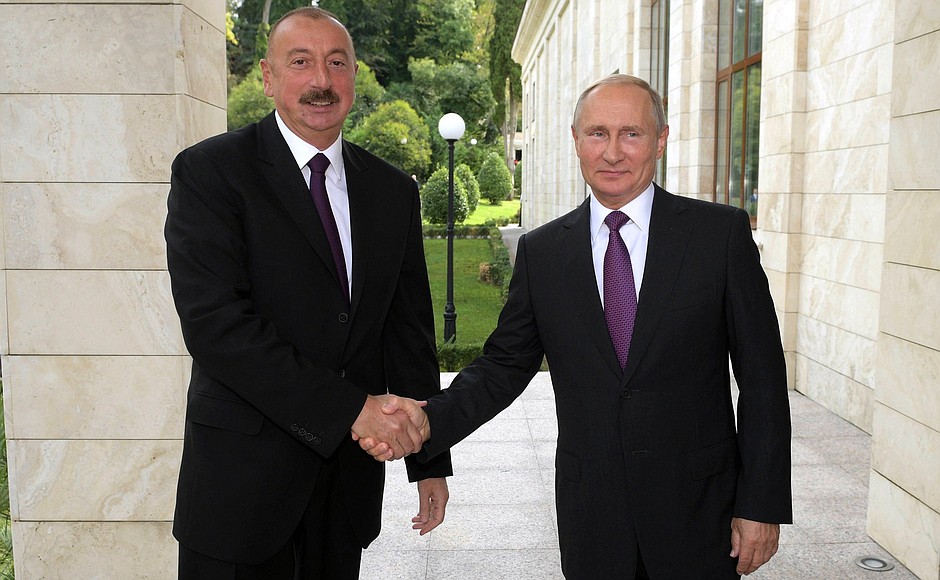One of the results of Azerbaijan’s President Ilham Aliyev’s visit to Russia on Saturday was the signing of a bilateral agreement to complete the construction of a cross-border bridge, considered an integral part of the International North-South Transport Corridor.
"One of the most promising projects is the creation of an international transport corridor "North-South," which will connect European markets with Asian producers [and] will significantly accelerate the transport of goods from South Asia and the Middle East through Iran to Europe," Russia’s President Vladimir Putin said in a meeting with President Aliyev in Sochi on Saturday, according to TASS.
"I emphasize that work on certain sections of the route is already underway. Next year our countries intend to complete the construction of the bridge across the border river Samur.”
The bridge has been first initiated in 2013. The new, three-lane bridge, measuring 325.3 meters in length and 17.3 meters in width, is designed to replace an old highway that was built in 1957. Construction work kicked off in 2017, but the project was never completed.
The cross-border bridge is incorporated into the North-South Transport Corridor and includes the border region between northern Azerbaijan and southern Russia. The corridor's largest section measures 2,923 kilometers and incorporates seven Russian cities, namely Makhachkala, Astrakhan, Tambov, Saratov, Ryazan, Moscow and St. Petersburg. Buslovskaya station in St. Petersburg is the last stop along the corridor within Russia before it cuts into Europe via Helsinki, Finland.
"This year, 100 times more cargo was transported through the North-South Transport Corridor than in the past year, and this is only the beginning, as this large-scale global project will cover countries and continents," President Aliyev said in the meeting with his Russian counterpart.
For its part, Azerbaijan laid down an 8.3-kilometer railway line from its southern Astara station to the Iranian border, and launched a railway bridge across the Astarachay River. Azerbaijan absorbs about 511 km (317.5 mi) of the route, via railway and highway connections, which cut vertically across its terrain and linking Iran in the south to Russia in the north.
The 7,200 km (4,473 mi) multi-modal International North-South Transport Corridor, which had been conceived by Iran, Russia and India in 2000, consists of rail, maritime and road routes, stretching from ports across India to northern Europe vertically through the Caspian region’s Iran, Azerbaijan, and Russia. The freight and logistics capability of the route are estimated at around six million tons of freight per annum across Eurasia during the first years of operation. However, over time, the capacity of the corridor will ultimately be increased to somewhere between 15 and 20 million tons per year.
The main goal of the corridor is reducing the cost and time for shipping goods within Eurasia from India toward northern Europe in Finland and Europe’s western edge in Germany. An overland ride from St. Petersburg to Mumbai measures 7,200 km via the all-new corridor, while the same route stretches along 16000 km through the Suez Canal and Northern Africa. Goods deliveries will take just 20 days, instead of 45 days, after INSTC goes online, sometime within the next year.
Two dry runs on INSTC were arranged in 2014 with the first from Mumbai to Baku via Bandar Abbas and the second from Mumbai to Astrakhan via Bandar Abbas, Tehran, and Bandar Anzali. The results revealed that transportation costs were reduced by $2,500 per 15 tons of cargo via these two primary shipment bottlenecks. Masterminds of INSTC consider other routes across the Caspian port cities including Aktau in Kazakhstan and Turkmenbashi in Turkmenistan.







 Azerbaijan and Armenia started the process of demarcation of their border on Tuesday, with the installation of the first border markers based on ge...
Azerbaijan and Armenia started the process of demarcation of their border on Tuesday, with the installation of the first border markers based on ge...
 Armenian sappers commenced on Monday mine-clearance operations in the territories adjacent to the Saint Mary Church in village of Voskepar (Armenia...
Armenian sappers commenced on Monday mine-clearance operations in the territories adjacent to the Saint Mary Church in village of Voskepar (Armenia...
 Iran and Pakistan have signed eight cooperation documents in various fields, and agreed to strengthen ties to fight terrorism in the region.
Iran and Pakistan have signed eight cooperation documents in various fields, and agreed to strengthen ties to fight terrorism in the region.
 President Aliyev emphasized the critical role of the North-South Transport Corridor in fostering transport cooperation between Azerbaijan and Russi...
President Aliyev emphasized the critical role of the North-South Transport Corridor in fostering transport cooperation between Azerbaijan and Russi...



